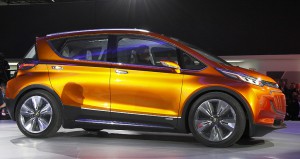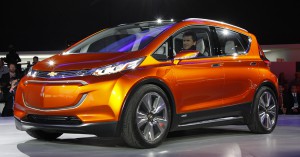
Chevy's Bolt EV concept can travel 200 miles on a single charge, according to GM CEO Mary Barra. Photo credit: Len Katz.
General Motors fired an opening salvo against Tesla in the war for electric vehicle superiority today by introducing the Chevrolet Bolt, an EV concept capable of traveling 200 miles on a single charge.
GM Chief Executive Officer Mary Barra described the Bolt “an affordable, long-range all electric vehicle designed to offer more than 200 miles of range starting around $30,000.
“The Bolt EV concept is a game-changing electric vehicle designed for attainability, not exclusivity. Chevrolet believes electrification is a pillar of future transportation and needs to be affordable for a wider segment of customers.”
Electric vehicles are still plagued by an age-old conundrum: range v. price. The more you’re willing to pay, i.e. Tesla’s Model S at $80,000-plus, the more range you get. One of the keys for EV success is breaking that formula and the Bolt may be the first step.
Alan Batey,GM executive president, acknowledged the Bolt could challenge Tesla’s Model X, which is supposed to debut later this year.
“I haven’t seen a Tesla with our value equation,” he said.
Batey, however, declined to say if and when GM could build the Bolt. Those decisions are still pending, he said.
“What I am saying today is that this vehicle has a very important place in our portfolio,” he told reporters after GM’s official press conference. “We wouldn’t have talked about 200 miles of range and a $30,000 price unless we knew we could do it.”
No one else has the ability to offer a vehicle with a range of 200 miles and a price of $30,000. The Nissan Leaf costs less than $20,000, but its range is limited to around 100 miles.
(Buick Avenir could shatter expectations. For more, Click Here.)
Batey declined to discuss the battery technology that enhanced the Bolt’s range, but said GM will ready to discuss it in next few months as it releases more information about the science behind the car.
(Click Here for details about GM’s second-generation Volt.)
The Bolt utilizes lessons learned through the production of the Volt and Spark EV and is designed to offer long-range performance in all 50 states and many global markets, GM officials said.
Drivers will be able to select operating modes designed around preferred driving styles such as daily commuting and spirited weekend cruising, for uncompromising electric driving. The modes adjust accelerator pedal mapping, vehicle ride height and suspension tuning. The Bolt EV concept is also designed to support DC fast charging.
(Ford dropped a supercar bombshell in Detroit today! Click Here for the full report.)
Akshay Anand, analyst at Kelley Blue Book, said Tesla could use its mystique, particularly on the West Coast, where most EV’s are sold, to counter the competition from Chevrolet.
“Two hundred miles for $30,000 sounds like a great deal on the surface, and definitely puts the heat on Tesla’s Model 3 to knock it out of the park like the Model S did. With that said, if the Model 3 does in fact deliver similar range and pricing, many consumers may opt for the Tesla simply because of the nameplate assuming supply is available. Chevy will need other key features to differentiate, but it’s great to see the brand so committed to greener vehicles.”


As has been discussed with the Tesla models, 200 miles doesn’t cut it for most consumers who have one vehicle for all of their transportation needs. With no practical charging support infrastructure and the time required to recharge along with the off-route locations of charging stations or even battery replacement locations, EVs are still not practical for 99.9% of society.
It would appear that hydrogen fuel cells will replace battery powered EVs in the not so distant future as they have a reasonable range (300 miles) and refueling is similar to gas/Diesel cars though the infrastructure will still need to be built for refueling stations. These would likely just be added to existing gas stations making everything convenient and practical for those who want a fuel cell powered EV.
Too bad many electrical outlets are supplied by coal fired power plants. This makes all electric cars more of a polluter than internal combustion autos.
http://www.cbsnews.com/news/think-electric-cars-are-truly-green-not-if-their-power-comes-from-coal/
Looks like an electric (PEV) Chevrolet Spark!
First: An electric car powered purely from coal is STILL putting out less CO2 than a conventional gas car. Stop spreading lies.
#2 No, 99.9% of society doesn’t need a 500 electric car. The Tesla Supercharger networks rocks (and its free). 80% of Americans drive less than 30 miles in a day.
Hydrogen is just an energy carrier, not an energy source. There are no Hydrogen mines waiting to be tapped. Hydrogen is no produced as a byproduct of natural gas. The other way to do it is horribly inefficient. Where are the billions of dollars going to come from to build the infrastructure?
Different website, same ridiculous opinions.
Not really, Steve. Read our more extensive coverage of both electric and hydrogen, among other alternatives. Our job is to cover, question…and inform, not to cheerlead.
Paul A. Eisenstein
Publisher, TheDetroitBureau.com